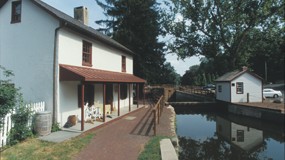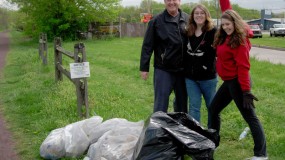The Magnificent Mule
Few people who lived and worked along the Canal could imagine building a life without the mule. Mules, it is said, were the engines of the Canal. Or put another way, the workhorses
moving coal from Mauch Chunk (present-day Jim Thorpe) to Bristol.
Mules—The Heart of the Canal
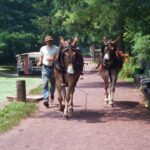 Favored by the founding fathers of our country, the mules established a stellar reputation when they came to the new world. Spanish missions used mules in their western North American missions in the early 1700s. George Washington, an avid farmer, became interested in utilizing mules and imported two male donkeys from Spain to begin a breeding program.
Favored by the founding fathers of our country, the mules established a stellar reputation when they came to the new world. Spanish missions used mules in their western North American missions in the early 1700s. George Washington, an avid farmer, became interested in utilizing mules and imported two male donkeys from Spain to begin a breeding program.
When the King of Spain and Marquis de Lafayette, both close friends of Washington heard of the new president’s breeding efforts, they also sent male donkeys to increase the stock. These donkeys from Spain and Andalusia were prized for their size and were called mammoth donkeys.
A mule is the asexual bi-product of breeding a female horse or mare with a male donkey or jack. Washington already owned mares to breed with these donkeys and eventually had more mules than horses on his estate.
The interest in mules spread throughout the South as Washington promoted using these animals in agriculture, even campaigning one of his donkeys to breed with mares. Thomas Jefferson also became a convert and soon had a breeding program and his own mules on the grounds of Monticello.
Man and Mule
Mules were put to work across America. They were used in agriculture, construction, mining, Continued on following page and transportation. These hardy equines pulled wagons, carriages, and canal boats.
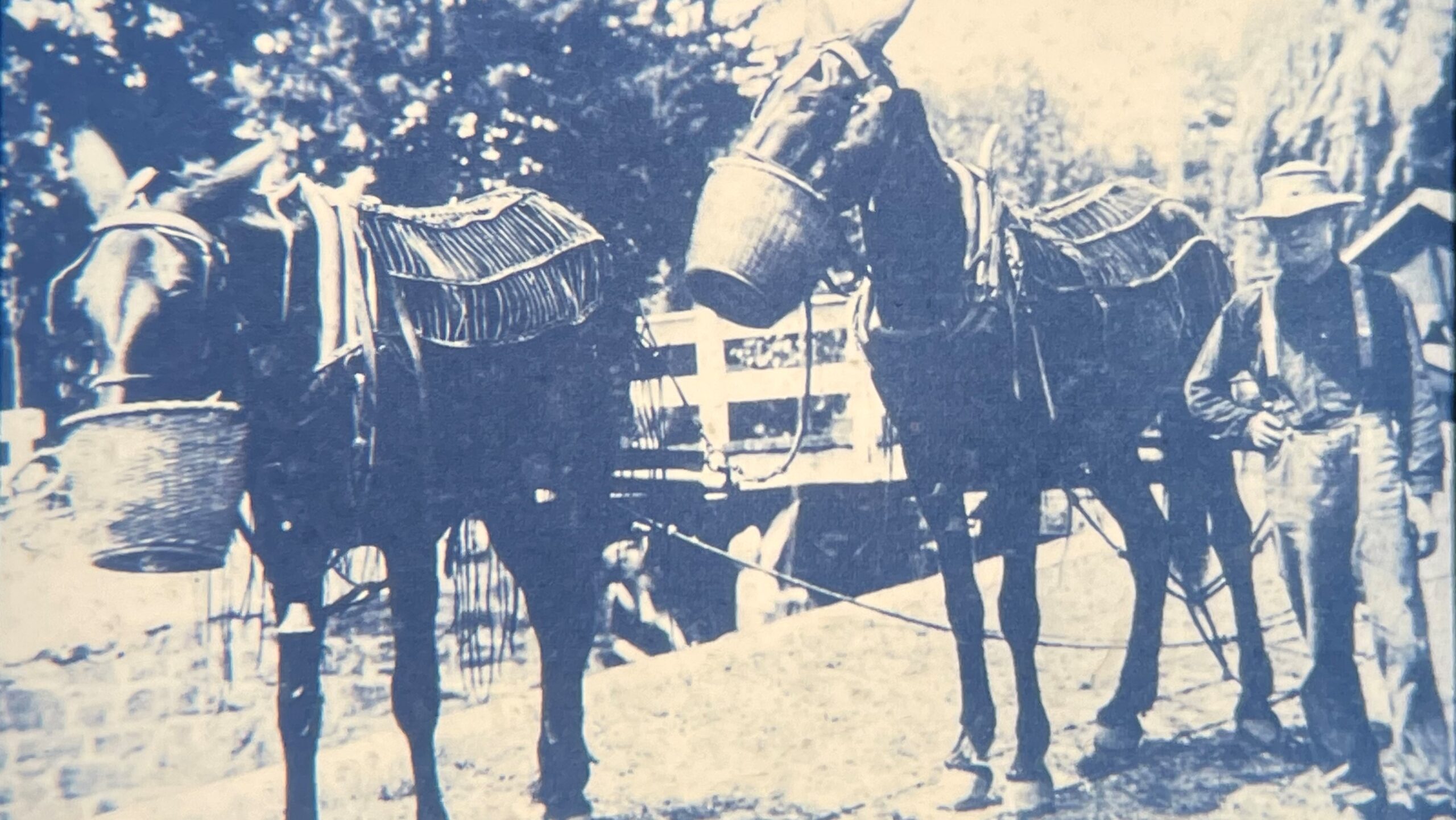 So, when commerce on the Delaware Canal began, mules were the logical choice. From the perspective of the canal boat operator, mules had several distinct advantages. They had a sturdy constitution and were not prone to health problems. They could work long hours, perhaps slower than a horse, but they would keep going. The structure of the mule’s hoof increases its stability, and mules have fewer foot-related problems than horses. And mules seem to be calmer, exhibiting more common sense than a horse. According to author Rinker Buck, who wrote a book about his experience retracing the Oregon Trail in a covered wagon pulled by three mules, “Mules have a larger cranial capacity and thus larger brains than horses—a gift from their feral, burro side—and they ponder things a lot more.”
So, when commerce on the Delaware Canal began, mules were the logical choice. From the perspective of the canal boat operator, mules had several distinct advantages. They had a sturdy constitution and were not prone to health problems. They could work long hours, perhaps slower than a horse, but they would keep going. The structure of the mule’s hoof increases its stability, and mules have fewer foot-related problems than horses. And mules seem to be calmer, exhibiting more common sense than a horse. According to author Rinker Buck, who wrote a book about his experience retracing the Oregon Trail in a covered wagon pulled by three mules, “Mules have a larger cranial capacity and thus larger brains than horses—a gift from their feral, burro side—and they ponder things a lot more.”
Buck also admired the strong constitution of the mule. “Draft horses are too highly bred and, at almost a ton apiece, too heavy for long wagon journeys. They have stamina for only about 10 to 15 miles a day, have tremendous appetites, and cannot last very long without water or in the extreme heat of the deserts. Draft mules, however, weigh about 700 pounds less, can go long distances without water and barely perspire in the heat.”2
For the Canal Boatmen, mules were a perfect fit. They were calm, smart, and could work long hours without needing a rest. The tough
skin of this equine helped protect them from harness sores even after an 18-hour day.
Outfitting a Canal Mule
Canal boatmen purchased most of their mules from the company operating the Canal. For the Delaware Canal, that company was the Lehigh Coal and Navigation Company. Boatmen would also buy the harness and other supplies from Lehigh Coal. The company would then deduct these expenses from the captain’s pay.
The Delaware Canal Journal describes the sale of young mules that the company would import from Kentucky and Missouri. According to one boatman, Grant Emery, “The Kentucky
mules were better, or fancier looking, but they didn’t hold up as well. I know my people were always Missouri mule men.”1
Once the young mule was purchased and fitted for a harness, they were shod and tattooed with a number on the sole of a front foot. That number was used not only to identify the owner of the mule but to ensure the company could track and charge the boatman for the cost of the animal and equipment.
Getting to Work
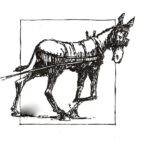
The canal boat crew could vary, but at the very least, it included a captain, a tiller, and mule driver. Very often, the family of the Canal boat operator was on board to help with the daily routine. Often small children were called into service as mule drivers. One woman told of her experience as a mule driver on her father’s boat. Madeline Free Rilleria said, “I loved the animals,
and they loved me, and they used to cry for me and whinny every once in a while, when they knew I was getting tired and then I would crawl up on their backs and make a bed on there.”1
A day on the Canal started at 3:30 a.m. with grooming the mules and getting them ready for the day’s journey. Some boatmen liked to feed their animals a ration of food before starting the day; others liked to get the mules moving before feeding them on the towpath with a feedbag. After harnessing the mule team was done, the captain would toss the towline to a helper on the towpath, who would attach it to the mule team.
Once they started, the crew would take turns at the tiller while someone cooked breakfast. Often, boat captains, who were confident in their mule teams, could leave them unattended to continue their towpath journey while the mule drivers took a break. Some captains were not lucky, and their animals would nibble greenery along the way. This annoying habit was called bushwhacking, a term generally used for clearing a path; its use seems appropriate here.
At the end of the day, around 10:00 pm, the captain would stop at a stable. Stables were located near locks and at other points along the canal. Some canal towns, like Uhlerstown not only offered a stable but blacksmith and boat repair services along with food and other supplies.
Once the harnesses were removed, most mules liked to have a good roll (a characteristic they are well known for), scratching and stretching before their evening repast and rest.
Caring for the mules
The value and importance of this equine cannot be understated. Mules played an essential role in the boatman’s success, and canallers ensured their animals were well cared for, including
regular feeding as they walked the towpath, watering, grooming, and farrier care.
And to keep everyone honest, an SPCA inspector would travel the length of the Canal inspecting the condition of the mules. One boatman recalls, “You didn’t dare to be mean to your animals on the Delaware. They had a woman down there, she’d make you stop the mules and lift the collar; and, if there was a sore on his shoulder, you had to take that mule out, you couldn’t use him. She was all through the Delaware. You never know when you’d run into her.”1
A Most Noble Creature
Historically, mules have worked tirelessly for us. They ask little. They are easy keepers and very loyal to their owners. Once they bond with you, you have a friend for life. Mules are also
quick learners, so working with a mule requires consistency. When they know what is expected, they will provide hours of service.
Studies show mules are generally more intelligent than horses or donkeys. This intelligence means they will not do anything to harm themselves and they can be protective of their
owners. When handled and trained properly, they are gentle, loving members of a family.
Author Rinker Buck states, “A horse will pretty much respond like a dog to a master’s request; their first instinct is to obey. A mule says, at a difficult stream crossing or a narrow gate opening, “Now wait a minute here, let’s consider the safety of this.” That, too, comes from the burro side. Mules have a very strong feral instinct to protect themselves.” 2
So, mules may not dive off a steel pier with you, but they will be glad to stand by and cheer you on.
Flowers are Everywhere–on the Ground and in the Air
The Delaware Canal towpath spans 58.9 miles, and in that distance, you can spot many flowering plants along the way. Some are relatively obvious, and others require a keen eye. Here are a
few to look for.
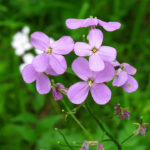 < Dame’s Rocket is a flowering biennial member of the mustard family. This plant has some historical significance as it was recorded as one of the first wildflowers imported to the colonies from Europe. Also known as Sweet Rocket, its fragrance is most pronounced in the evening sometimes confused with Phlox, the flower of Dame’s Rocket has four petals, versus Phlox, which has five. The flowers come in an assortment of spring colors, including white, pink, and purple. It prefers to grow in sunny, moist locations and can be found on the margins of marshes and woodlands. It is considered an invasive species in Pennsylvania.
< Dame’s Rocket is a flowering biennial member of the mustard family. This plant has some historical significance as it was recorded as one of the first wildflowers imported to the colonies from Europe. Also known as Sweet Rocket, its fragrance is most pronounced in the evening sometimes confused with Phlox, the flower of Dame’s Rocket has four petals, versus Phlox, which has five. The flowers come in an assortment of spring colors, including white, pink, and purple. It prefers to grow in sunny, moist locations and can be found on the margins of marshes and woodlands. It is considered an invasive species in Pennsylvania.
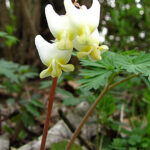 < Dutchman’s Breeches is a perennial herbaceous plant native to eastern North America. This diminutive woodland plant has white flowers that resemble pants hanging from a clothesline. According to the Bowman’s Flower Preserve Native Plant Guide, the flower is an early nectar source for emerging queen bees. As a member of the Dicentra family (bleeding heart), it is also called Little Blue Staggers because it appears to have a narcotic effect on cows causing them to seem drunk.
< Dutchman’s Breeches is a perennial herbaceous plant native to eastern North America. This diminutive woodland plant has white flowers that resemble pants hanging from a clothesline. According to the Bowman’s Flower Preserve Native Plant Guide, the flower is an early nectar source for emerging queen bees. As a member of the Dicentra family (bleeding heart), it is also called Little Blue Staggers because it appears to have a narcotic effect on cows causing them to seem drunk.
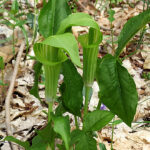 < Jack-in-the-Pulpit is an herbaceous, woodland, flowering perennial. This unusual, illusive plant generally flowers from April to June in Pennsylvania. And while they are not easy to spot, they are well worth the effort. These plants typically grow about 1 foot tall and have an interesting construction. The “pulpit” of the flower is called a spathe, a long leaf covering a cluster of flowers. The “jack” is a long stalk with flowers that can be male or female. However, this plant is not self-pollinating. It relies on small flies to help in that regard. The pungent odor of the plant tends to attract flies and other small insects. Jack-in-the-pulpit is often confused with the carnivorous pitcher plant. At the end of the summer, while the remaining plant withers. The female flowers turn into small red berries, which are a food source for birds. One source noted that native Americans used the red coloring as a dye.
< Jack-in-the-Pulpit is an herbaceous, woodland, flowering perennial. This unusual, illusive plant generally flowers from April to June in Pennsylvania. And while they are not easy to spot, they are well worth the effort. These plants typically grow about 1 foot tall and have an interesting construction. The “pulpit” of the flower is called a spathe, a long leaf covering a cluster of flowers. The “jack” is a long stalk with flowers that can be male or female. However, this plant is not self-pollinating. It relies on small flies to help in that regard. The pungent odor of the plant tends to attract flies and other small insects. Jack-in-the-pulpit is often confused with the carnivorous pitcher plant. At the end of the summer, while the remaining plant withers. The female flowers turn into small red berries, which are a food source for birds. One source noted that native Americans used the red coloring as a dye.
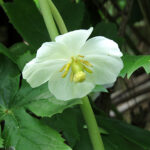 < Mayapples bloom in late spring after many ephemerals have faded. They grow in colonies in forested areas creating a canopy of umbrella-like plants. The plants bear one white flower, which matures into a yellow fruit and can be used to make jam. Harry Potter fans will be pleased to know that this herbaceous perennial is also known as mandrake.
< Mayapples bloom in late spring after many ephemerals have faded. They grow in colonies in forested areas creating a canopy of umbrella-like plants. The plants bear one white flower, which matures into a yellow fruit and can be used to make jam. Harry Potter fans will be pleased to know that this herbaceous perennial is also known as mandrake.
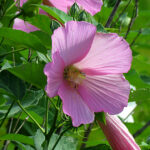 < Swamp Rose-mallow is a showy hibiscus and one of the largest perennials in our area. It can be spotted in wet and boggy areas next to the towpath and along the Canal banks in some areas and has established some large colonies. This is a winter-hardy plant with a decidedly tropical flair. The flower color ranges from white to pink to red with a crimson center and yellow stamen. These plants are host to several butterfly larvae and are a food source for hummingbirds as well.
< Swamp Rose-mallow is a showy hibiscus and one of the largest perennials in our area. It can be spotted in wet and boggy areas next to the towpath and along the Canal banks in some areas and has established some large colonies. This is a winter-hardy plant with a decidedly tropical flair. The flower color ranges from white to pink to red with a crimson center and yellow stamen. These plants are host to several butterfly larvae and are a food source for hummingbirds as well.
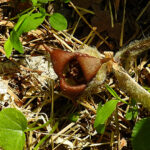 < Wild Ginger is a plant with a lot to offer. It grows in most forested areas and has some interesting adaptations. The flower has three triangular petals, which are hidden beneath heart-shaped leaves. Like the jack-in-the-pulpit, this plant relies on flying insects for pollination. As flies emerge in the spring, they are attracted to the flower, which looks and smells like carrion. The seeds are covered in an oily substance favored by ants who carry the seed back to their colony, eat the oily covering, and plant the seed. Native Americans and early settlers used the dried root of wild ginger as a spice. These plants also contain two antibiotic compounds and were used to make a poultice to treat wounds.
< Wild Ginger is a plant with a lot to offer. It grows in most forested areas and has some interesting adaptations. The flower has three triangular petals, which are hidden beneath heart-shaped leaves. Like the jack-in-the-pulpit, this plant relies on flying insects for pollination. As flies emerge in the spring, they are attracted to the flower, which looks and smells like carrion. The seeds are covered in an oily substance favored by ants who carry the seed back to their colony, eat the oily covering, and plant the seed. Native Americans and early settlers used the dried root of wild ginger as a spice. These plants also contain two antibiotic compounds and were used to make a poultice to treat wounds.
DON’T FORGET TO LOOK UP!
We have many flowering trees in the Delaware Canal state park as well. These include dogwoods, catalpa trees, magnolias, and Tuliptrees or Tulip Poplars. This poplar is fast growing and
can get very large. The trees provide a source of nutrition for many species. The large yellow flowers appear in early summer and are a source of nectar for ruby-throated hummingbirds.
Dogwoods can be seen throughout the park in early spring. They are understory trees, showing off a display of white blooms against the bright green of budding trees. The berries of the dogwood
are a favorite snack of birds and squirrels.
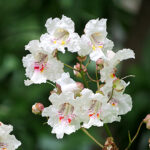 Northern Catalpas are fast-growing showy trees with large heart-shaped tropical-looking leaves. Due in part to its size and its abundant display of flowers, this shade tree has become a popular addition to suburban landscapes. The USDA, however, considers it an invasive weed tree, so if you like the almost wisteria-like blossoms
Northern Catalpas are fast-growing showy trees with large heart-shaped tropical-looking leaves. Due in part to its size and its abundant display of flowers, this shade tree has become a popular addition to suburban landscapes. The USDA, however, considers it an invasive weed tree, so if you like the almost wisteria-like blossoms
and the shade, a regular pruning is recommended.
Do you have a favorite flowering plant in the park?
Let us know, and please send pictures. We love pictures.
SOURCES:
USDA: fs.usda.gov/wildflowers
Bowman’s Wildflower preserve: bhwp.org/grow/native-plant-nursery/native-plant-catalog
High Park Nature Centre: highparknaturecentre.com
PA Enflowered: paenflowered.org
Morton Arboretum: mortonarb.org
PHOTO CREDITS:
Jack in the Pulpit by CCCP: Own work, CC BY-SA 2.5 ca, commons.wikimedia.org/w/index.php?curid=58750771
Wild Ginger courtesy of Fritz Flohr Reynolds, Wikipedia
PARK MANAGER’S REPORT
By Brian Heath
Park Manager, Delaware Canal State Park
We want to thank the Friends and all the volunteers who participated in the Annual Canal Clean-up event. Volunteers who are willing to sacrifice their time to help keep the park beautiful are invaluable.
STAFFING
A joint on-site hiring event with Tyler State Park was held at the Buckstone Farm Conference Center to fill vacant positions, including a laborer and a park resource ranger. The event attracted 17 candidates, with 14 interviewed. Interviews are underway for the remaining online applicants. Other vacancies continued to be posted for various positions. Interested applicants should visit employment.pa.gov or contact the park.
PROJECT UPDATES
Three project bids have been approved and will be awarded to a selected contractor. Once the contracts are finalized, scheduling, logistics, and closure information will be provided. The projects include:
● Flood damage repairs to a section of the berm and towpath in Easton(MP 59-53).
● Phase One of the 12 Bridge Project will target repairs for Smithtown Bridges 3 and 4 and the Sub-canal Culvert in Raubsville.
● Phase Two of the 12 Bridge Project will target repairs for two bridges in Upper Makefield, including Tebola Beans Bridge and the David Library Bridge. In the north, the bridges include the Canal
Road, North Bridge in Williams Township, and the Canal Lane Bridge in Bridgeton Township.
- High Falls Culvert replacement: A Hydrologic and Hydraulic Study that analyzes the movement of
water, including the volume and rate of flow, is nearing completion. A conceptual design is in review. - Spahr’s Authentic Camelback Truss Bridge: A conceptual design was presented to the Advisory Committee.
- Lumberville Aqueduct project: This rebuilding project is in the design phase, which is scheduled for completion before the end of the year.
NEW INITIATIVES
Giving Pond Naturalization Project: We are currently working on re-establishing the fields at the giving
pond. The open field near river road was once a wildflower field. It has been prepped and reseeded with a Pennsylvania native annual/ perennial mix of wildflower seeds. The fields by the towpath will require ongoing attention as grasses start to emerge and the autumn olive infestation is removed. We are working with Natural Resources staff as we re-establish the field moving forward. An improved access project is also underway to connect the towpath with giving Pond Parking area.
Ralph Stover Tree Planting:
Thirteen sapling trees have been planted at Ralph Stover to replace fallen Ash trees. The trees will take time to mature, but they will help restore the canopy over the picnic area. A memorial donation funded the purchase of these trees, including some flowering understory trees such as dogwoods, redbuds, and shade trees, including American Red Maple, American Beech, Black Gum, and Willow Oak. The park staff will continue to plant trees, as possible, to restore the rustic wooded nature of the park.
WATER
The Centre Bridge Pump is now online, providing water for the 3-mile stretch between Centre Bridge and Lock 11. The Friends are working as intermediaries with residents, collecting money to fund the electricity needed to run the pump. New Hope, and areas north of Lock 11, usually are watered from the Delaware River inlet in Easton. However, damage sustained during Hurricane Ida in Upper Black Eddy and Lumberville has stopped the flow. DCNR is working diligently to repair these structural failures. The Delaware River inlet in New Hope feeds the Canal south of Lock 11. In advance of significant forecasted rain events, staff will lower the water in anticipation of higher volumes, but after the storm, we resume normal levels. As the dry summer months approach, if the Delaware River falls below 9 feet on the Trenton River gauge, the water stops flowing in from the inlet. If this continues for several days, areas south of New Hope will begin to dry up. The river level and the level of the canal during times of drought are beyond the control of the park.
MOWING AND TREE REMOVAL
Our staff in the northern section of the park is starting mowing operations. The purchase of additional equipment should speed up our process as long as the staff is available to run the tractors. Due to the difficulty of getting the parts needed for a clam jaw, we are getting a late start on removing fallen trees which may impact mowing in the early season. However, we are moving along and catching up.
Mowing operations in the south will commence soon, likely starting in Bristol toward the end of this month. This year, in certain areas, such as Buckstone Farm, we will cut the grass slightly higher than in previous years to see if it will help deter the geese. Geese like the young grass shoots that grow after a cutting. Allowing the grass to grow longer makes it less palatable for these birds.
The southern maintenance staff has been removing trees that have fallen into the canal and working on towpath repair. These are time consuming tasks requiring personnel and equipment. Some sections of the towpath are narrow, challenging our access with certain vehicles. In other cases, access alone to parts of the towpath that need attention is extremely difficult. We are working to ensure that the towpath is safe for towpath users as they make repairs to potholes and other muddy sections. We understand the frustrations with gravel size and
are working to improve the issue as time and manpower allow.
CLOSURES
Giving Pond River Access: The river access at the Giving Pond Recreation Area will be CLOSED. The purpose of this closure is for PUBLIC SAFETY and RESOURCE PROTECTION. The closure will be in effect until further notice. Park users should NOT attempt to get by the closure. Trespassing violations will be addressed accordingly.
IT’S A WRAP
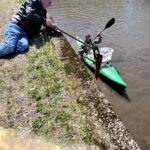 Our annual Clean-up Day event got off to a rainy start, but we are pleased to announce that nearly all sections of the towpath were given a proper spring cleaning throughout the month
Our annual Clean-up Day event got off to a rainy start, but we are pleased to announce that nearly all sections of the towpath were given a proper spring cleaning throughout the month
of April. Groups of volunteers, armed with rakes, grabbers, bags and gloves got to work. Many sections of the canal and towpath were very clean. Other areas needed a thorough scrubbing.
This year, we had several volunteers who bought along their canoes and kayaks to clean some hard-to-reach spots on the berm bank and of course, in the water.
We had over 100 people sign-up to help. And the teams gathered nearly 100 bags of trash along with a bicycle, a few shopping carts and, tires, lots of tires.

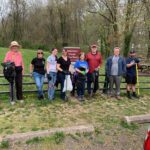 WE GREATLY
WE GREATLY
APPRECIATE EVERYONE’S
EFFORTS AND WANT TO
SEND A BIG SHOUT OUT
TO THE FRIENDS WHO
HELPED SCHEDULE,
COORDINATE AND
EQUIP OUR VOLUNTEER
CLEAN-UP TEAMS.
CANAL TENDERS. OUR PARK HEROES.
They bike, they jog
They poke, they prod
They search and grab
Until they have
A bag full of trash.
 With our annual Canal Clean-up behind us, it is time to reflect on the year-round dedication of our Canal Tenders. After our annual spring-cleaning
With our annual Canal Clean-up behind us, it is time to reflect on the year-round dedication of our Canal Tenders. After our annual spring-cleaning
event, many Clean-up Crews reported less trash and debris. We know our Canal Tenders are making an impact.
This year was the first year all, but three sections of the Canal had someone to look after it, cleaning up trash as they could and reporting problems they encountered. These dedicated volunteers regularly provide feedback on downed trees, sinkholes, tough towpath conditions, and sightings of large debris in the Canal. So, our Canal Tenders play an essential role in keeping the public safe.
We send this information to the Park Management team with location information so the park staff can follow up and resolve any hazardous issues.
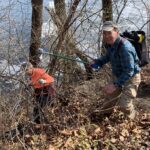 The towpath is nearly 60 miles long, making it difficult to manage in the best circumstances. When you combine the park’s size with the effect of storms, trees, and people, DCNR has a lot
The towpath is nearly 60 miles long, making it difficult to manage in the best circumstances. When you combine the park’s size with the effect of storms, trees, and people, DCNR has a lot
of ground to cover. The park staff is well aware of the positive impact the Canal Tenders have on the preservation and improvement of our beloved Delaware Canal State Park. They appreciate this team of people who regularly monitor the entire length of the Canal and towpath.
If you would like to become a Canal Tender, we have several openings in the southern area of the Canal. These sections include:
● Beaver Street to Bristol Lagoon – Bristol Borough
● Bristol Lagoon to Green Lane – Bristol Borough
● Green Lane to Edgely Avenue – Bristol Township
Our Canal Tenders are passionate about preserving and maintaining the Canal and towpath for future generations. We are so grateful for their commitment to the park and the community.
So, next time you are on the towpath, you can show your solidarity and pick up trash along the way. Together we can all make a difference.
Environmental Stewardship Award
The Friends of the Delaware Canal is proud to have received an award for Environmental Stewardship from the Lower Makefield Township Board of Supervisors.
Over the past 15 years, the board’s Environmental Advisory Council (EAC) has given this recognition to groups “who have made significant achievements in improving and sustaining
the quality of our environment.” The Friends’ commitment to restoring, preserving, and improving the Delaware Canal and Towpath resonated with the EAC. They look
for organizations that impact several areas, including pollution prevention, resource conservation, sustainability, environmental education, and environmental leadership.
In attendance to receive the award were FODC Board President Brett Webber, Secretary Jack Torres, Executive Director Michael Ginder, and retired FODC Executive Director Susan Taylor. “We are very honored to have received the 2022 Environmental Stewardship Award from the Lower Makefield Township Environmental Action Council and the Board of Supervisors.” said Michael Ginder, “The award recognizes our achievements over the last 40 years to help improve, restore, and promote the Delaware Canal and empower us to continue our work to protect this important natural resource.”
PENNSBURY PARTNERSHIP PROGRAM

FODC Executive Director , FODC; Laure Duval, FODC Board Vice President.
Last year, the Pennsbury School District asked Michael Ginder, Executive Director of the Friends, to present a program on the Delaware Canal, including a towpath clean-up and scavenger hunt to a group of seventh-grade students. They had a chance to learn about the history of the canal and its impact on our area while making their own impact by picking up trash along the way.
As a result of our participation, Pennsbury selected the Friends as a recipient of the Annual Pennsbury Partnership Award. The Pennsbury Partners Program was launched 20 years ago and has grown to over 1,000 partners. Each year the Partners Program recognizes a Business Partner and a Non- Profit Partner for their contributions to the school district.
The official ceremony occurred on Wednesday, April 19, at the Middle School in Yardley. Michael Ginder accepted the award for the Friends. The corporate recipient this year was Yogamazia. Michelle El Khoury, the owner of Yogamazia, was on hand to receive this recognition.
Along with the Pennsbury Partners Award, the Friends received a Certificate of Recognition from State Representative Perry Warren, who also attended the ceremony, recognition from State Senator Steve Santarsiero’s office and Congressman Brian Fitzpatrick, who recognized the Friends with a special commendation and flag which flew over the Capital.
